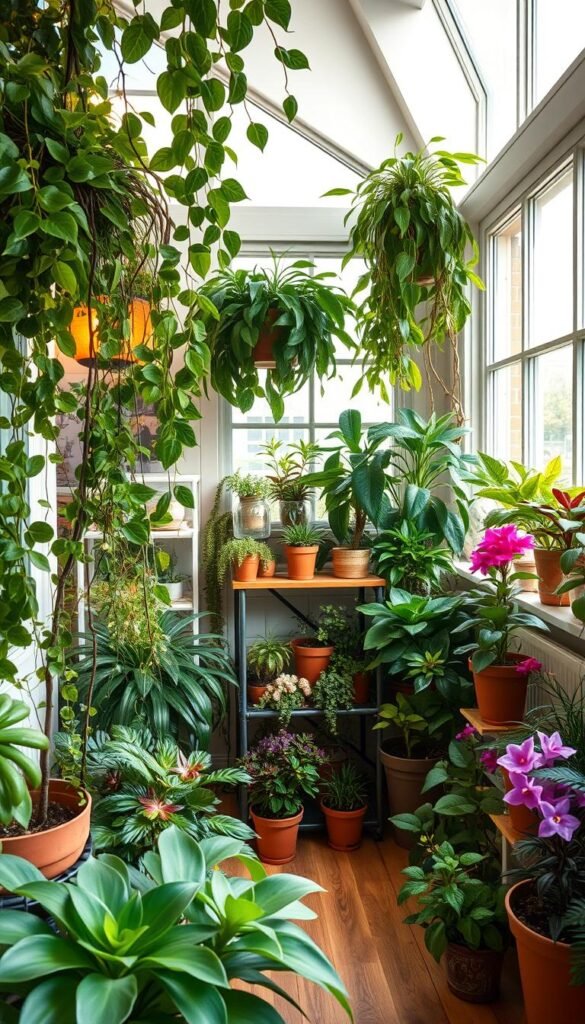Transforming limited areas into vibrant green retreats is easier than you think. With clever design and modern innovations, even the coziest corners can burst with life. Whether you’re working with a studio apartment or a narrow balcony, there’s always room to grow something beautiful.
Vertical arrangements like wall-mounted planters or repurposed shelves let you build upward instead of outward. Hydroponic setups eliminate soil mess while providing precise nutrient control – perfect for kitchens or offices. Windowsills become micro-farms when lined with herbs or succulents that thrive in sunlight.
Greenery does more than beautify your surroundings. Studies show living plants purify air, reduce stress, and boost focus. You’ll find joy in nurturing mint for cocktails or watching ivy cascade from hanging baskets. For step-by-step guidance, explore these DIY indoor garden projects that turn household items into plant displays.
Smart choices make all the difference. Compact varieties like snake plants or dwarf citrus trees deliver big impact without crowding floors. Rotate containers seasonally to keep your arrangement fresh and functional. With the right strategy, every room becomes an opportunity to reconnect with nature’s calming presence.
Embracing the Challenge of Indoor Gardening in Tight Spaces
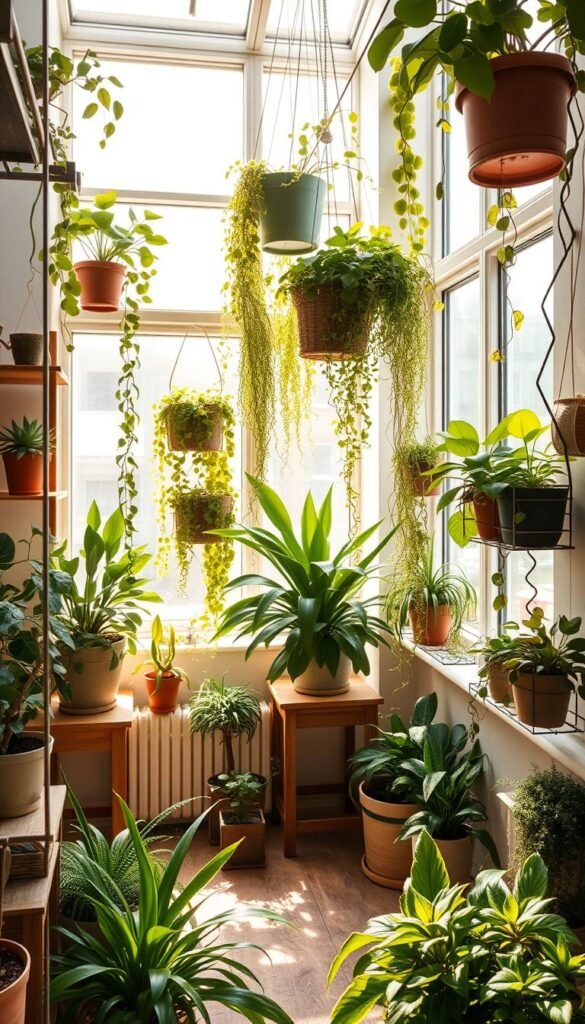
Living in limited square footage doesn’t mean sacrificing your green thumb ambitions. With thoughtful planning, you can cultivate thriving indoor plants that transform functional areas into rejuvenating oases. The secret lies in seeing possibilities where others see limitations.
Understanding Your Space Potential
Start by observing daily light patterns in your home. South-facing windows work best for sun-loving varieties like rosemary, while ferns flourish in shady corners. Measure humidity near showers or kitchens for moisture-loving species.
| Plant Type | Light Needs | Space Efficiency |
|---|---|---|
| Herbs | 4-6 hrs sunlight | Fits 6″ pots |
| Succulents | Bright indirect | Vertical growth |
| Ferns | Low light | Hanging baskets |
Benefits of a Greener Home Environment
Your leafy companions do more than look pretty. They filter airborne toxins while boosting oxygen levels – NASA studies show certain species remove up to 87% of pollutants in 24 hours. You’ll notice fewer headaches and better sleep quality.
Regular plant care becomes a calming ritual. Watering routines and leaf inspections ground you in the present moment. Friends will marvel at how you’ve turned that awkward corner into a vibrant display of life.
Small Indoor Garden Ideas: Maximizing Tight Spaces for Lush Foliage
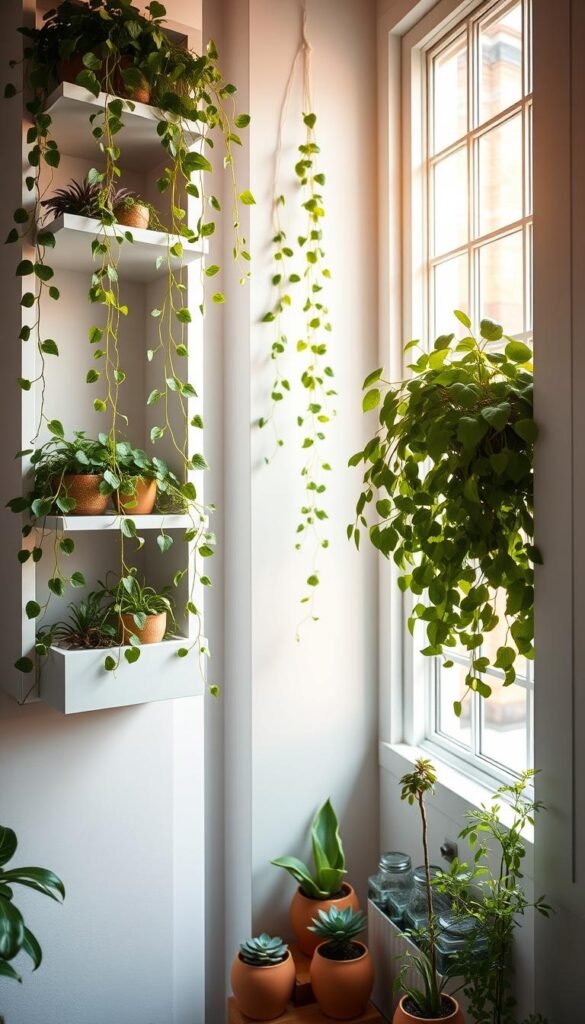
Unlocking hidden potential in compact living areas starts with smart design choices. Focus on plants that serve multiple purposes – think rosemary for cooking and air purification. Aloe vera doubles as decor while soothing burns, proving functionality doesn’t sacrifice style.
Layering becomes your secret weapon. Place trailing vines on high shelves, medium-sized plants at eye level, and compact herbs on countertops. This approach creates depth while ensuring each species gets proper light exposure.
| Plant | Key Benefits | Space Needs |
|---|---|---|
| Basil | Culinary use, pest repellent | 8″ pot |
| Spider Plant | Air purification, easy propagation | Hanging planter |
| Lavender | Stress relief, fragrance | 12″ container |
| Pothos | Low light tolerance, vertical growth | Wall-mounted pot |
Companion planting works indoors too. Pair moisture-loving ferns with tropical species that enjoy similar humidity. Keep drought-tolerant succulents separate from water-hungry herbs to simplify care routines.
Transform ordinary objects into gardening tools. Repurpose tiered dessert stands as plant displays, or use magnetic spice racks for tiny potted herbs. These hacks maximize every inch without cluttering surfaces.
Rotate your green companions seasonally. Move sun-loving varieties closer to windows in winter, then swap positions when light patterns shift. This keeps your indoor garden thriving year-round while refreshing your space’s look.
Transforming Windowsills into Mini Farms
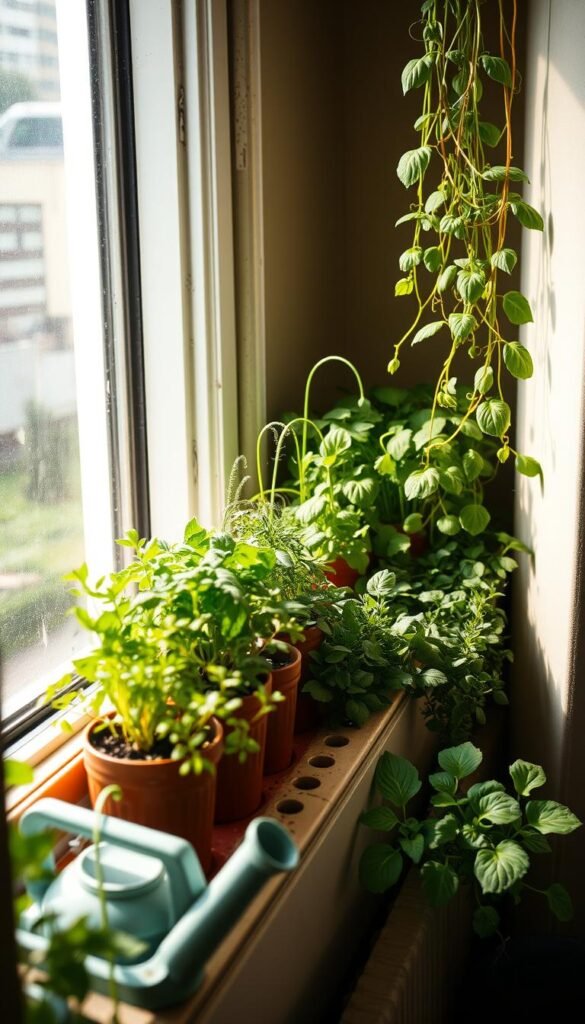
Your windowsill holds untapped potential for fresh flavors and vibrant greenery. By adding slim shelves and matching containers to your glass space, you’ll multiply growing areas while keeping surfaces clutter-free. This approach turns passive sunlight into an energy source for thriving plants.
Maximizing Natural Daylight
Window direction determines what grows best. South-facing spots bathe plants in 6-8 hours of intense rays – perfect for basil and cherry tomatoes. East or west exposures offer milder morning or afternoon light, ideal for spinach and mint.
| Window Direction | Best Crops | Daily Light Hours |
|---|---|---|
| South | Herbs, peppers | 6-8 |
| East/West | Lettuce, kale | 4-6 |
| North | Moss, ferns | 2-3 |
Optimizing Shelf and Pot Arrangements
Use tiered shelves to create a vertical farm within your window frame. Shallow pots work for herbs, while deeper containers support root vegetables like radishes. Keep these tips in mind:
- Place taller plants at the back to avoid shading smaller ones
- Rotate pots weekly for even growth
- Add reflective foil behind containers to boost light exposure
With smart layouts, you’ll harvest salad greens weekly while new seedlings develop below. This continuous cycle turns your growing plants into a self-renewing food source that fits any kitchen layout.
Vertical Gardening and Hanging Container Innovations
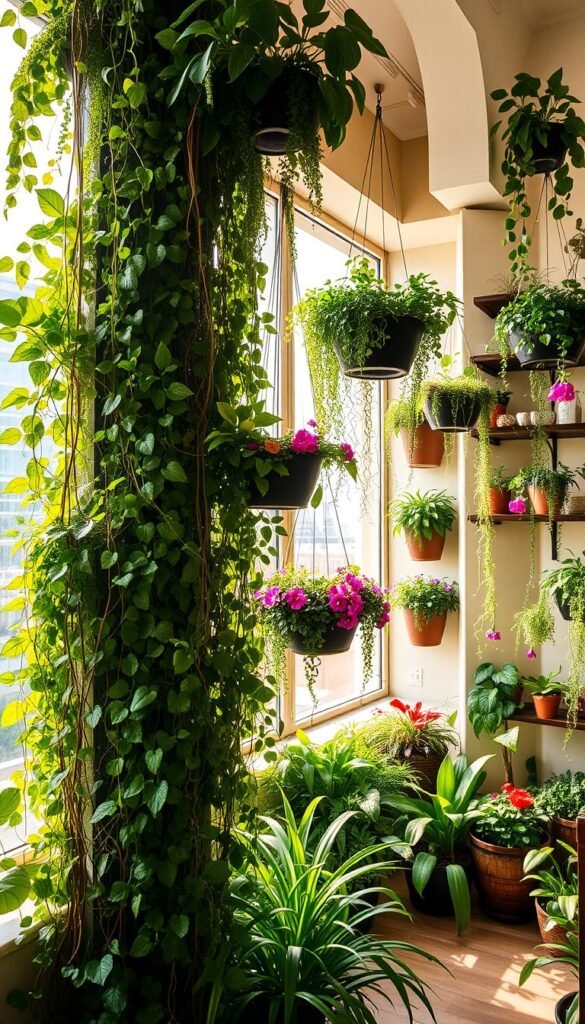
Elevate your greenery game by looking up – walls and ceilings offer prime real estate for cultivating life. Vertical systems let you grow plants where floor space runs short, transforming blank surfaces into dynamic displays. These solutions work particularly well in apartments or rooms with limited square footage.
DIY Vertical Garden Ideas
Turn everyday items into plant havens with simple upgrades. Old shoe organizers become instant gardening stations when filled with herbs like thyme or oregano. For sturdier setups, mount wooden pallets against a wall and line shelves with waterproof liners.
Fabric pocket systems let you customize layouts while keeping roots contained. Use breathable materials like canvas to prevent waterlogging. Always secure structures with heavy-duty brackets – mature plants can weigh more than you expect!
Exploring Stacking Planters and Planting Towers
Modular systems let you build upward as your collection grows. Stackable containers let mint share space with strawberries in tiered arrangements. Tower gardens squeeze 20+ plants into a footprint smaller than a trash can.
Hanging baskets solve tricky placement issues. Suspend trailing ivy near windows or position herb clusters above kitchen islands. Macrame hangers add bohemian flair while keeping floor areas clear.
Choose species with shallow roots for vertical setups. Pothos, spider plants, and air-purifying ferns adapt well to elevated life. Pair varieties with similar water needs to simplify care routines.
Hydroponic Systems for Compact Indoor Spaces
What if your favorite herbs grew faster while using 90% less water? Modern hydroponic systems make this possible, turning cramped areas into high-yield growing zones. These soil-free solutions deliver nutrients directly to roots through optimized water circulation, accelerating growth rates by up to 50% compared to traditional methods.
Countertop Hydroponic Setups
Compact units fit beside coffee makers or under cabinets, perfect for beginners. You’ll harvest basil and lettuce in weeks rather than months. The closed-loop design recirculates nutrient solutions, slashing water use by 80-90% compared to potted plants.
Wall-Mounted Nutrient Film Techniques
Vertical channels transform blank walls into cascading gardens. Roots dangle in shallow streams of enriched water, absorbing exactly what they need. Use repurposed pipes or bamboo to create custom layouts that match your space constraints.
These systems excel in controlled environments. Pair them with LED lights to grow tropical fruits or rare herbs year-round. For advanced gardening techniques, explore these innovative growing solutions that maximize vertical surfaces.
Maintenance becomes simple with practice. Test nutrient levels weekly using affordable meters. Rotate crops every 6-8 weeks for continuous harvests. Your plants grow vigorously without battling soil pests or uneven moisture.
Aquaponics: Merging Fish Care with Plant Growth
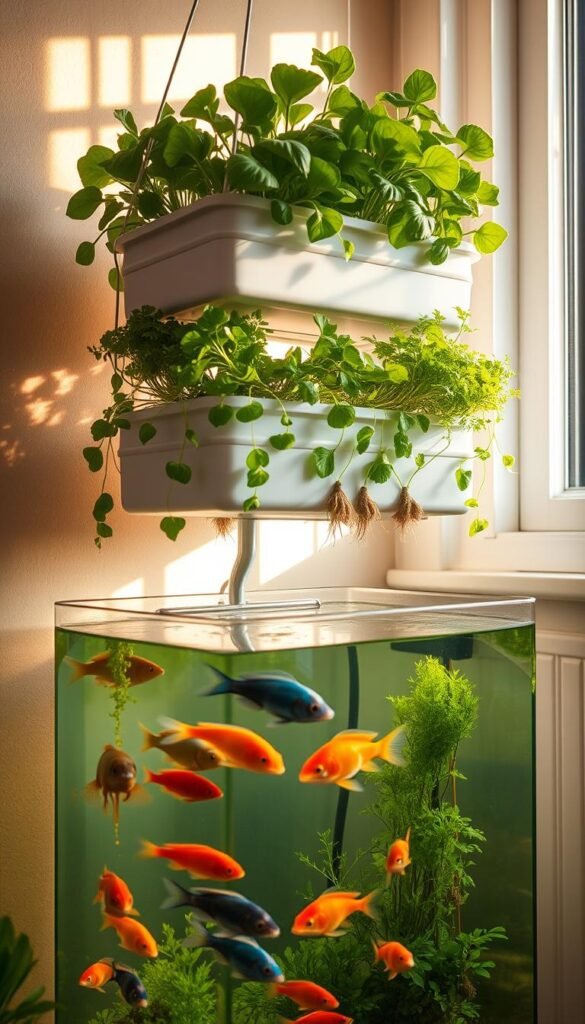
What if your plants could feed your fish while cleaning their water? Aquaponics creates this clever partnership, turning a fish tank into a living fertilizer factory. This closed-loop system grows vibrant plants and healthy fish in the same water supply – no synthetic nutrients required.
You’ll need just 3 components to start: a fish tank, grow bed, and water pump. Beneficial bacteria convert fish waste into plant food, while roots filter the water for your aquatic friends. It’s nature’s recycling program on your countertop.
Setting Up Small-Scale Aquaponic Systems
| Fish Species | Space Needs | Plant Partners | Harvest Time |
|---|---|---|---|
| Goldfish | 10 gal minimum | Lettuce, herbs | 6-8 weeks |
| Tilapia | 55-gal drum | Tomatoes, peppers | 12-16 weeks |
| Catfish | 30-gal tank | Kale, spinach | 10-14 weeks |
Start with leafy greens and decorative fish to master the nitrogen cycle. Test kits help monitor ammonia levels until bacteria colonies stabilize. For budget-friendly aquaponic setups, repurpose food-safe containers as grow beds.
Feed fish high-quality pellets to ensure nutrient-rich water. Scale your system gradually – add more plants as fish grow. This balance keeps both components thriving without overwhelming your space.
Families love watching ecosystems develop. Kids learn biology through daily feedings and plant progress. You’ll harvest crisp veggies and enjoy tranquil fish movements – all within your existing indoor environment.
Multi-Functional Furniture: Planters that Serve Double Duty
Your furniture can do more than hold drinks or store blankets—it can breathe life into your home. Clever designs now merge storage solutions with living elements, letting you grow plants where you once only kept clutter. These pieces prove greenery belongs in every corner of your room, not just on windowsills.
Creative Storage Meets Natural Beauty
Imagine a coffee table with built-in containers for herbs or a bench that hides potting soil beneath its seat. Ottomans with removable tops reveal space for trailing vines, while bookshelves incorporate horizontal planters between novels. You’ll organize your space while surrounding yourself with nature’s calming influence.
Room dividers take on new purpose when filled with pothos or spider plants. They create privacy screens that purify air as they grow. For DIY projects, line drawers with waterproof liners and drill drainage holes in old cabinets. Your revamped furniture becomes a thriving part of your indoor ecosystem.
These hybrid pieces solve two problems at once. You gain functional storage while introducing plant life to your living areas. Every item in your home now works harder—and looks fresher—than ever before.

